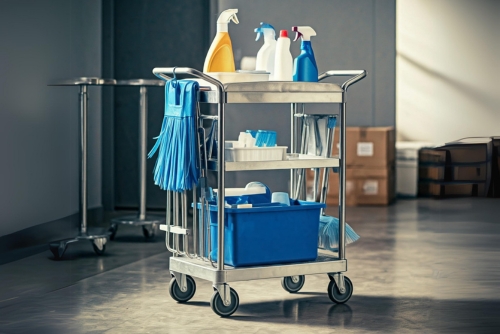
Housekeeping carts play a crucial role in maintaining cleanliness and efficiency in various settings, from hotels to hospitals. Well-organized housekeeping carts can significantly enhance productivity, streamline operations, and ensure that cleaning tasks are performed smoothly and efficiently.
These essential tools are crucial for streamlining the cleaning process and ensuring that housekeeping staff can work quickly and effectively. In this comprehensive guide, we’ll delve into 10 essential tips for organizing your housekeeping carts to maximize their effectiveness and utility.
The Importance of Organized Housekeeping Carts
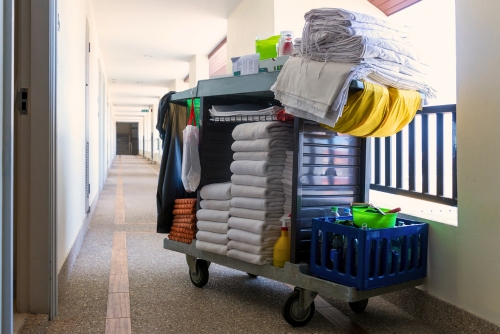
An organized housekeeping cart is more than just a convenience—it's a vital tool for maintaining order and efficiency. Housekeeping carts play a pivotal role in the cleanliness and overall guest experience in hotels and motels.
Whether you're managing a hotel, a hospital, or any other facility that requires regular cleaning, having a well-organized cart ensures that your staff can easily access the necessary supplies and tools, leading to faster and more effective decontaminating. An organized trolley allows housekeeping staff to work more efficiently, minimizing downtime and reducing the risk of forgetting essential supplies. Proper organization also contributes to a safer work environment and helps maintain the highest standards of cleanliness.
Why Housekeeping Carts are Essential for Efficient Cleaning?
Housekeeping carts are designed to carry all the necessary supplies and equipment needed for various tasks. By having everything in one place, these trolleys streamline the process of moving from one room to another. This not only saves time but also reduces physical strain on housekeeping staff.
The Benefits of a Well-Organized Housekeeping Cart
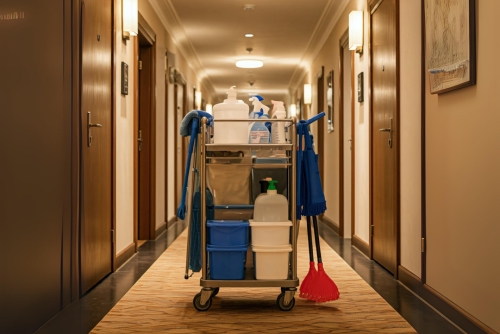
A cluttered cart can impede cleaning productivity in multiple ways. Disorganization leads to wasted time searching for supplies and can result in incomplete or inconsistent cleaning. Moreover, a disorganized cart can increase the risk of accidents, such as spills or equipment falling. An organized housekeeping cart offers several benefits:
- Increased Efficiency: With everything in its place, staff can quickly locate and use the required items.
- Enhanced Productivity: Fewer interruptions mean staff spend more time cleaning and less time searching for supplies.
- Improved Safety: Properly organized carts reduce clutter and prevent accidents.
- Better Maintenance: Regularly maintained carts reduce the need for repairs.
Overview of the 10 Tips
In this guide, we will cover ten practical tips to help you organize your housekeeping carts effectively, including decluttering, strategic stocking, and ensuring ease of use. Each tip will contribute to optimizing your cart's performance and ensuring that your crew operates at peak efficiency. Watch this video for expert tips on organizing your housekeeping cart.
Understanding Your Housekeeping Cart
Types of Housekeeping Carts
Before diving into the organization tips, it’s essential to understand the various types of housekeeping carts available:

- Foldable Utility Carts: These are versatile and can be easily stored away when not in use.
- Janitorial Carts: Designed specifically for janitorial tasks, these often come with multiple shelves and compartments.
- Cleaning Carts for Hotels: Tailored to the needs of hotel housekeeping, these are equipped with features to handle a wide range of cleaning supplies.
- Commercial Housekeeping Carts: Built for heavy-duty use in commercial settings, these are durable and often have large storage capacities.
- Hospitality Housekeeping Carts: These are designed for the unique needs of hospitality settings, including features like lockable compartments and specialized storage for linens.
Key Features to Consider
When selecting or organizing your housekeeping cart, consider these key features:
- Storage Capacity: Ensure the cart has enough space to hold all necessary supplies.
- Maneuverability: Choose a trolley that is easy to navigate through tight spaces.
- Durability: Opt for carts made from robust materials that can withstand daily use.
- Cleaning Supplies Organization: Look for carts with compartments and adjustable shelves to keep supplies organized.
Tip 1: Declutter Your Cart
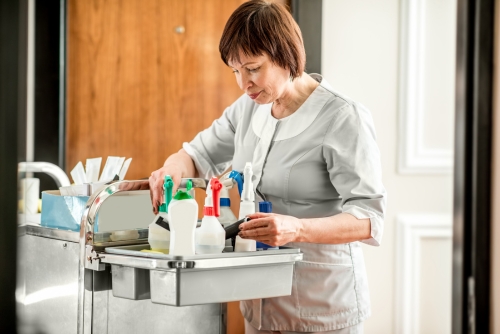
Start by removing any items that are not essential for your tasks. This will free up space and make it easier to organize the remaining supplies.
Group similar items together, such as cleaning chemicals, tools, and rags. This will make it easier to find what you need when you need it.
Develop a checklist of essential cleaning supplies to keep track of what should be on the trolley at all times. This ensures that you always have what you need without cluttering the cart with excess items.
Tip 2: Organize by Task
Arrange supplies according to the specific cleaning tasks they are used for. For instance, keep floor washing tools together and separate from those used for surface decontaminating.
Implement a color-coding system to easily identify and organize supplies. This method helps in quickly locating items and reduces the chance of mixing up different solutions.
Labeling compartments and shelves can significantly enhance organization. Use clear and visible labels to indicate what each section contains.
Tip 3: Utilize Storage Solutions
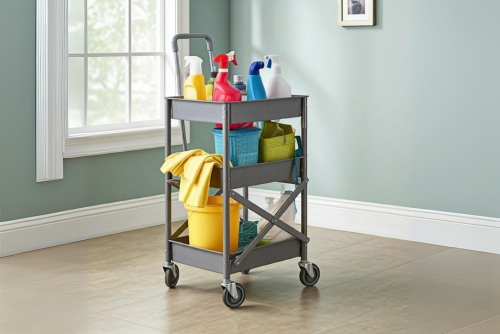
Use baskets and bins to organize small items like sponges, gloves, and cleaning cloths. These containers prevent clutter and make it easy to access frequently used items.
Incorporate hanging pockets to store tools and brushes. This keeps them within reach while freeing up space on the cart’s shelves.
Equip your cart with shelves and drawers to store larger items and equipment. This helps in organizing bulky items and maintaining a clean appearance.
Consider adding accessories such as cup holders or additional hooks to further enhance the cart’s functionality and organization.
Tip 4: Keep Your Cart Clean
Ensure that the cart itself is regularly cleaned and disinfected to prevent cross-contamination. This is particularly important in settings like hospitals and hotels.
Take precautions to avoid stains and spills on the cart. Use liners or trays to protect surfaces and make it easier.
Regularly check for any signs of wear or damage that could affect the cart’s hygiene. Promptly address any issues to maintain a clean and safe working environment.
Tip 5: Stock Your Cart Strategically
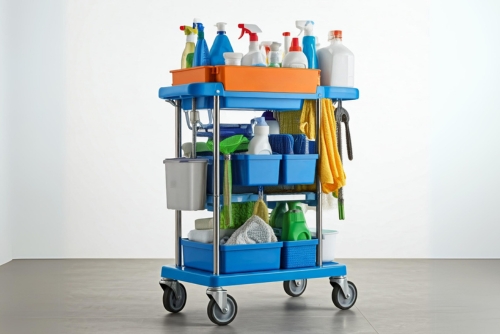
Ensure your cart is stocked with all essential housekeeping supplies, including disinfecting solutions, tools, and safety equipment.
Adjust the cart’s contents based on seasonal needs, such as including additional supplies for winter months or extra products during peak seasons.
Keep a small supply of emergency items, such as first aid kits and spill kits, readily available on the cart.
Establish a routine for checking and replenishing supplies to ensure that the trolley is always fully stocked and ready for use.
Tip 6: Consider Cart Weight and Balance
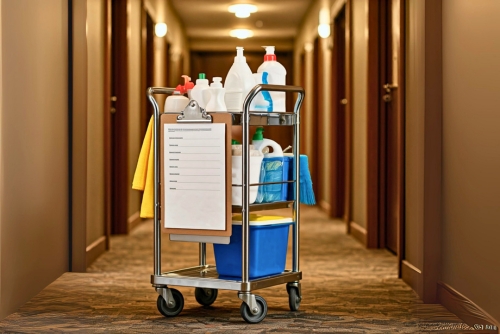
Ensure that the weight on the cart is evenly distributed to maintain stability and ease of maneuverability.
Do not overload the rolling unit, which can affect its performance and lead to safety issues. Follow the manufacturer’s guidelines for maximum load capacity.
Opt for lightweight materials where possible to reduce the overall weight of the trolley and make it easier to maneuver.
Tip 7: Optimize Your Cart for Efficiency
Design the cart’s setup to be ergonomically friendly. Ensure that handles are at a comfortable height and that the cart is easy to push and pull.
Arrange supplies in a way that maximizes accessibility. Frequently used items should be within easy reach to save time and effort.
Incorporate features that save time, such as quick-access compartments and easily removable bins.
Tip 8: Customize Your Cart
Add personal touches to your trolley to make it more user-friendly and tailored to your needs. Custom colors or decals can also help you easily identify your cart.
Adjust the cart’s configuration to fit the unique requirements of your tasks and environment.
Explore DIY customization ideas to enhance your cart’s functionality, such as adding additional storage or modifying existing features.
Tip 9: Train Your Housekeeping Staff
Train your housekeeping staff on the correct use and organization of the cart to ensure consistency and efficiency.
Provide safety guidelines for handling cleaning supplies and using the trolley to prevent accidents and injuries.
Educate staff on best practices for keeping the cart organized and maintaining cleanliness.
Tip 10: Regular Maintenance
Regularly inspect the cart for any signs of damage or wear. Address any issues promptly to maintain its functionality. Replace any worn-out parts or accessories to keep the carrier in top condition and ensure it continues to perform effectively. Implement a maintenance schedule to keep your trolley in optimal condition and extend its lifespan.
Recap of the 10 Tips
In summary, organizing your housekeeping carts effectively involves decluttering, strategic stocking, utilizing storage solutions, and maintaining cleanliness. By following these ten tips, you can enhance the efficiency and effectiveness of your operations.
A well-organized carrier not only improves productivity and safety but also ensures that your cleaning crew operates efficiently and effectively. Encourage consistent organization and maintenance practices to keep your housekeeping carts in top shape and ready for use. By applying these tips, you'll ensure that your housekeeping carts are organized, efficient, and fully equipped to meet the demands of your tasks. Discover the top-rated housekeeping carts for hotels.
How Long Do Housekeeping Carts Last?
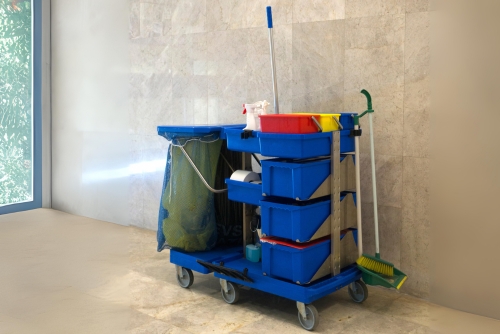
The lifespan of a housekeeping cart depends on several factors, including the materials used, frequency of use, and maintenance practices. Typically, a high-quality cleaning cart made from durable materials like heavy-duty plastic or stainless steel can last between 3 to 10 years. Here are some essential factors that impact the longevity of a janitorial cart:
- Material Durability: Carts made from robust materials like steel or reinforced plastic last longer than those with cheaper, lightweight materials. For example, stainless steel utility carts resist rust and corrosion, making them ideal for long-term use in humid or chemical-prone environments.
- Usage Frequency: Carts that are used frequently in high-traffic environments like hotels, hospitals, or commercial spaces experience more wear and tear. A service cart used daily may require more frequent maintenance and parts replacement to ensure longevity.
- Maintenance: Proper care and maintenance play a vital role in prolonging a housekeeping trolley's life. Regularly cleaning, disinfecting surfaces, tightening screws, and replacing worn-out wheels or bins can add years to a cart’s lifespan.
- Load Capacity: Overloading a utility cart beyond its recommended weight limit can lead to premature damage. Following the manufacturer's weight guidelines will help maintain smooth operation and extend its life.
- Environmental Conditions: Carts used in harsh environments, such as outdoor areas or locations exposed to chemicals and moisture, may experience faster degradation. Choosing a utility trolley built for these conditions can mitigate damage.
When selecting a housekeeping cart or janitorial trolley, it's important to choose a reliable brand that offers both durability and functionality. Rubbermaid, a top service cart brand, caters to industries like hospitality, healthcare, and commercial cleaning. A trusted name in housekeeping carts, Rubbermaid offers a wide variety of janitorial carts with lockable compartments, ample storage space, and easy maneuverability. Their carts are highly durable, making them a top choice for high-traffic areas in hotels and hospitals.
Frequently Asked Questions
What is a cleaning cart called?
A cleaning cart, commonly known as a janitorial cleaning cart, housekeeping cart, or cleaning trolley, is an essential tool designed to streamline the cleaning process. These carts come in various configurations, including small cleaning carts on wheels and portable cleaning trolleys, tailored to suit different cleaning needs and environments. The purpose of these carriers is to hold and transport cleaning supplies and equipment efficiently, ensuring that cleaning tasks are completed quickly and effectively.
What should be on a housekeeping cart?
A well-stocked housekeeping cart is equipped with a variety of essential items to ensure efficiency during cleaning tasks. Key supplies include cleaning solutions such as all-purpose cleaners and disinfectants, cleaning tools like brooms, mops, and microfiber cloths, and personal protective equipment including gloves and masks. Additionally, the carrier should have waste disposal items like trash bags and waste containers. For those looking to enhance organization, a housekeeping cart organizer can help keep everything in its place and easily accessible.
How do you organize a janitorial cart?
Organizing a janitor cart effectively involves grouping similar items together and using designated spaces for each category. For instance, cleaning solutions should be kept in one section, while tools and personal protective equipment have their designated spots. Prioritizing accessibility is crucial, so frequently used items should be placed where they are easily reachable. Using commercial cleaning carts or a Rubbermaid housekeeping cart with built-in compartments can further enhance organization by providing specific spaces for different items.
How do you stock a cleaning cart?
To stock a cleaning trolley properly, start by identifying the essential supplies needed based on the cleaning tasks at hand. Choose appropriate cleaning solutions, tools, and safety equipment to include. Organize these items in the trolley's designated areas for easy access and ensure that the cart is restocked regularly. For specialized tasks or smaller spaces, a small cleaning cart on wheels or portable cleaning cart may be ideal, providing flexibility and ease of movement.
Why should you avoid overstocking a housekeeping cart?
Overstocking a housekeeping cart can create several issues that hinder efficiency. An overcrowded cart may reduce accessibility, making it difficult to locate and retrieve necessary items quickly. Additionally, an overloaded trolley becomes heavier and more challenging to maneuver, potentially slowing down the cleaning process. To avoid spills or accidents, particularly with cleaning solutions, it’s important to balance the trolley's load and only stock essential items.
How do you prepare a maid's cart?
Preparing a maid’s cart involves several key steps. Ensure that the cart is fully stocked with all necessary cleaning supplies and tools. Organize the items for easy access, placing frequently used tools and solutions in the most accessible areas. Check the cart for any damage or functional issues and address them before use. For enhanced efficiency, consider using a Rubbermaid commercial housekeeping cart or a housekeeping cart organizer to streamline the setup and maintain order.
How to arrange a housekeeping trolley?
Arranging a housekeeping trolley effectively involves dividing the cart into sections for different types of supplies. Prioritize accessibility by placing frequently used items within easy reach and use organizers like bins or baskets to keep items neatly arranged. Regularly assess and adjust the arrangement based on practical use to ensure that the trolley remains functional and efficient. For added convenience, consider investing in commercial cleaning carts or Rubbermaid housekeeping carts that offer built-in organizational features. Rubbermaid cleaning carts are designed for easy maintenance and adhere to top industry standards. Environmentally friendly and versatile options, such as the Microfiber Janitor Cart with Color-Coded Pails and the High-Security Housekeeping Cart, offer exceptional utility, convenience, and storage capacity, enhancing overall efficiency.
How do you maintain the cleanliness of the housekeeping cart?
Maintaining the cleanliness of a housekeeping cart requires regular attention. After each use, wipe down all surfaces with a disinfectant to remove dirt and spills. Inspect the cart for any damage or issues and address them promptly. Empty and clean waste containers regularly to prevent odors and residue buildup. Keeping track of supplies and restocking as necessary will help avoid clutter. For easier maintenance, a small cleaning trolley on wheels might be beneficial for frequent cleaning and maneuverability.
What are the common supplies loaded on the maid's cart or trolley?
Common supplies loaded on a maid's trolley include various cleaning solutions such as all-purpose cleaners and disinfectants, essential cleaning tools like brooms, mops, and dusters, and waste management items including trash bags and waste containers. Additionally, personal protective equipment like gloves and masks is crucial for safety. For specific needs, you might consider options such as a janitorial cart for sale or a Rubbermaid housekeeping cart for additional features and functionality.
How do you arrange cleaning equipment?
Arranging cleaning equipment involves grouping similar items together and ensuring that frequently used tools are easily accessible. Use designated spaces for different categories of supplies, such as a section for cleaning solutions and another for tools. To enhance organization, employ racks, bins, or hooks to keep equipment in place and prevent clutter. Consider using a housekeeping cart or commercial cleaning cart with built-in storage solutions for optimal arrangement.
How do you make a cart system?
Creating a trolley system involves designing a layout with specific areas for different types of supplies and implementing storage solutions like bins and baskets to keep items organized. Train staff on how to use and maintain the system effectively, and regularly review and adjust the layout based on practical use and feedback. For a streamlined setup, exploring options such as the best commercial cleaning carrier can provide features that support an efficient trolley system.
How do you sanitize a cart?
Sanitizing a cart involves several steps to ensure hygiene. Start by cleaning all surfaces with a disinfectant or cleaning solution to remove dirt and germs. Dispose of any waste and clean waste containers thoroughly. Ensure that all cleaning tools and supplies are sanitized as well. Implementing a regular cleaning schedule will help maintain the cart’s hygiene. For a cart that simplifies sanitation, consider a housekeeping cart or a Rubbermaid housekeeping cart with features designed for easy cleaning and maintenance.
Visit Winsham website today for more expert tips on The Ultimate Guide to Janitorial Supplies and Hotel Cleaning Products, and Cost-Effective Cleaning Supplies in Canada. Our expert team is dedicated to providing you with the best products and advice to enhance your cleaning routines and maximize productivity.
Don’t forget to follow us on social media for regular updates and exclusive offers, product updates, and insightful housekeeping tips to help you keep your facility running smoothly! Also, explore the Executive Compact Housekeeping Cart in action on YouTube, where we demonstrate its versatility and efficiency in various cleaning tasks.
Stay connected with us for all your cleaning and housekeeping needs.

